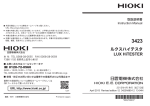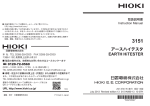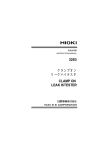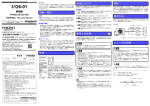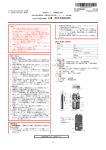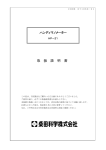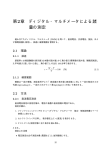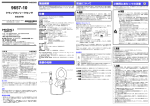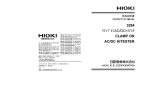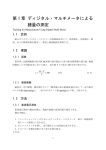Download クランプオンリークハイテスタ CLAMP ON LEAK HiTESTER
Transcript
取扱説明書 Instruction Manual 3283 クランプオンリークハイテスタ CLAMP ON LEAK HiTESTER 2013年 3月 発行 改訂18版 March 2013 Revised edition 18 3283A980-18 13-03H 目次 1 ―――――――――――――――――――――――――― 目次 はじめに 点検 安全について ご使用にあたっての注意 各章の内容 第 1 章 製品概要 1.1 製品の概要 1.2 本器の特長 1.3 各部の名称と機能 第 2 章 測定方法 2.1 測定準備 2.2 漏れ電流の測定 A∼ 2.3 フィルタ機能 FILTER 2.4 データホールド機能 HOLD 2.5 レコード機能 REC 2.6 オートパワーオフ機能 APS 2.7 電池消耗警告 2.8 ブザー音 2.9 ファストモード 2.10 出力機能 OUTPUT 第 3 章 電池の交換方法 第 4 章 ハンドストラップの付け方 第 5 章 仕様 5.1 測定仕様 5.1.1 交流電流 Arms(真の実効値表示) 5.1.2 周波数 Hz 5.2 一般仕様 第 6 章 故障とお考えになる前に 第 7 章 アフターサービス 1 1 2 5 9 11 11 12 13 17 17 18 24 25 25 29 29 29 30 31 35 37 39 39 39 40 41 45 47 ――――――――――――――――――――――― 目次 2 ―――――――――――――――――――――――――― ――――――――――――――――――――――― 1 __________________________________________________ はじめに このたびは、HIOKI“3283 クランプオンリークハイテ スタ”をご選定いただき、誠にありがとうございます。 この製品を十分にご活用いただき、末長くご使用いた だくためにも、取扱説明書はていねいに扱い、いつも お手元に置いてご使用ください。 お願い 本書の内容は、万全を期して作成しましたが、万一ご 不明な点や誤り、記載漏れなど、お気づきの点があり ましたら、お買上店(代理店)か最寄りの営業所にご 連絡ください。 点検 本器がお手元に届きましたら、輸送中において異常ま たは破損がないか点検してからご使用ください。特に 付属品および、パネル面のスイッチ、キー、端子類に 注意してください。万一、破損あるいは仕様どおり動 作しない場合は、お買上店(代理店)か最寄りの営業 所にご連絡ください。 付属品 9399 携帯用ケース ハンドストラップ 電池 6F22 (006P) 取扱説明書 1 1 1 1 オプション 9094 出力コード 9445-02 AC アダプタ 1 1 _____________________________________________ 2 __________________________________________________ 安全について 危 険 この機器は IEC 61010 安全規格に従って、設計され、試 験し、安全な状態で出荷されています。測定方法を間違え ると人身事故や機器の故障につながる可能性があります。 取扱説明書を熟読し、十分に内容を理解してから操作して ください。万一事故があっても、弊社製品が原因である場 合以外は責任を負いかねます。 この取扱説明書には本器を安全に操作し、安全な状態 に保つのに要する情報や注意事項が記載されています。 本器を使用する前に下記の安全に関する事項をよくお 読みください。 安全記号 ・使用者は、機器上に表示されている マークの ところについて、取扱説明書の マークの該当 箇所を参照し、機器の操作をしてください。 ・使用者は、取扱説明書の中の マークのあると ころは、必ず説明を読み注意する必要があるこ とを示します。 交流(AC)を表示します。 直流(DC)を表示します。 絶縁保護具(電気用ゴム手袋、電気用ゴム長靴、安 全帽など)を着用して、活線状態の電路に着脱でき ることを示します。 _____________________________________________ 3 __________________________________________________ 取扱説明書の注意事項には、重要度に応じて以下の 表記がされています。 危険 操作や取り扱いを誤ると、使用者が死亡または重傷に つながる危険性が極めて高いことを意味します。 警告 操作や取り扱いを誤ると、使用者が死亡または重傷に つながる可能性があることを意味します。 注意 操作や取り扱いを誤ると、使用者が傷害を負う場合、 または機器を損傷する可能性があることを意味します。 注記 製品性能および操作上でのアドバイス的なことを 意味します。 _____________________________________________ 4 __________________________________________________ 測定カテゴリについて 本器は CATIII に適合しています。 測定器を安全に使用するため、IEC61010 では測定カ テゴリとして、使用する場所により安全レベルの基準 を CATⅡ∼CATⅣで分類しています。 CAT II コンセントに接続する電源コード付き機器(可搬 形工具・家庭用電気製品など)の一次側電路 コンセント差込口を直接測定する場合は CAT Ⅱで す。 CAT III 直接分電盤から電気を取り込む機器(固定設備) の一次側および分電盤からコンセントまでの電路 CAT IV 建造物への引込み電路、引込み口から電力量メー タおよび一次側電流保護装置(分電盤)までの電 路 カテゴリの数値の小さいクラスの測定器で、数値の大 きいクラスに該当する場所を測定すると重大な事故に つながる恐れがありますので、絶対に避けてください。 カテゴリのない測定器で、CAT Ⅱ∼ CAT Ⅳの測定カ テゴリを測定すると重大な事故につながる恐れがあり ますので、絶対に避けてください。 _____________________________________________ 5 __________________________________________________ ご使用にあたっての注意 本器を安全にご使用いただくために、また機能を十二 分にご活用いただくために、下記の注意事項をお守り ください。 危 険 ・使用前には、保存や輸送による故障がないか、点検と動作確 認をしてから使用してください。故障を確認した場合は、お 買上店(代理店)か最寄りの営業所にご連絡ください。 ・クランプセンサの先端を開いた時、および測定中の短絡、人 身事故などを避けるために、被測定導体が安全電圧を超え 300 V までの測定をする場合は、過電圧カテゴリⅢ、汚染度 2、動作電圧 300 V の基礎絶縁を満足する絶縁導体を使用し てください。 なお、下線部の用語は下記の規格を参照してください。 IEC 61010-1 (JIS C 1010-1) IEC 61010-2-031 (JIS C 1010-2-031) IEC 61010-2-032 (JIS C 1010-2-032) ・クランプセンサの先端を開いたときの短絡、人身事故などを 避けるために、裸導体には使用しないでください。 ・AC300 Vrms を超える電路では使用しないでください。300 V を超えると感電事故や短絡事故になります。 ・本器は、必ずブレーカの二次側に接続してください。ブレー カの二次側は、万一短絡があっても、ブレーカにて保護しま す。一次側は、電流容量が大きく、万一短絡事故が発生した 場合、損傷が大きくなるので、測定しないでください。 ・AC アダプタは、指定の 9445-02 AC アダプタを必ず使用し てください。AC アダプタの定格電源電圧は AC100V∼ 240V(定格電源電圧に対し 10%の電圧変動を考慮していま す) 、定格電源周波数は 50/60 Hz です。本器の損傷および電 気事故を避けるため、それ以外の電圧での使用は絶対にしな いでください。 _____________________________________________ 6 __________________________________________________ 警 告 ・本器をぬらしたり、ぬれた手で測定しないでください。感 電事故の原因になります。 ・活線で測定するので、感電事故を防ぐため、労働安全衛生 規則に定められているように、電気用ゴム手袋、電気用ゴ ム長靴、安全帽等の絶縁保護具を着用してください。 ・感電事故を避けるため、変圧器の第 2 種接地工事の接地線 で測定する場合、高圧の機器や配線に接近しないようにし てください。また、高圧の充電部に近接したり、測定が困 難な箇所は、あらかじめ接地線の線路変更をしてくださ い。 ・感電事故を避けるため、クランプ部分を被測定物より外し てから、ケースを開け、電池を交換してください。また、 交換後は、必ずバックケースをしてから、ネジ留め後使用 してください。 ・電池交換するときは極性+−に注意し、逆挿入しないでく ださい。性能劣化や液漏れの原因になります。 ・使用済の電池をショート、分解または火中への投入はしな いでください。破裂する恐れがあり危険です。 ・使用済の電池は地域で定められた規則に従って処分してく ださい。 _____________________________________________ 7 __________________________________________________ 注意 電流 [A] ・精密機器なのでクランプセンサ先端部に異物等を挟んだり、 クランプセンサの隙間に物を差し込んだりしないでくださ い。 ・本器の損傷を避けるため、運搬および取り扱いの際は振動、 衝撃を避けてください。特に、落下などによる衝撃に注意し てください。また、クランプセンサに不要な力を加えたり、 測定箇所に無理にこじ入れたりしないでください。 ・本器の損傷を避けるため、最大入力範囲を超える電流を入力 しないでください。最大入力範囲は測定電流の周波数によっ て異なります。 (下図参照) 周波数 [Hz] 周波数によるディレーティング特性 _____________________________________________ 8 __________________________________________________ 注意 ・電池交換時に、電池スナップの金具がしっかりと接続され ているか確認してください。金具にゆるみがあった場合 は、金具を調整し、確実に接続されるようにしてくださ い。確実に接続されていないと、電源が入らなかったり、 使用中に電源が切れる場合があります。 ・内部メモリ保護のため、AC アダプタの抜差しは、電源を 切ってから行ってください。 ・この機器は室内用に設計されています。安全性を損なわな いで 0℃∼40℃の温度まで使用できます。 ・直射日光や高温、多湿、結露するような環境下での保存や 使用はしないでください。変形、絶縁劣化を起こし、仕様 を満足しなくなります。 注 記 ・直流が重畳している電路は、正確な測定ができない場 合があります。 ・トランスや大電流路など強磁界の発生している近く、 また無線機など強電界の発生している近くでは、正確 な測定ができない場合があります。 ・電池消耗時は マークが点灯します。確度保証はで きませんので、ただちに交換してください。 _____________________________________________ 9 __________________________________________________ 各章の内容 この説明書は各章ごとに下記の内容になっております。 「はじめに」∼第 1 章まではご使用前の注意と本器の 概要および特長が説明してありますので、必ずお読み ください。 第1章 製品概要 概要と各部の名称・機能について説明しています。 第2章 測定方法 3283 クランプオンリークハイテスタを使用しての測定 方法について説明しています。 第3章 電池の交換方法 3283 クランプオンリークハイテスタで使用している電 池の交換方法について説明しています。 第4章 ハンドストラップの付け方 ハンドストラップの付け方を説明しています。ハンド ストラップを付けると操作性が増します。 第5章 仕様 3283 クランプオンリークハイテスタの仕様を記載して あります。 第6章 故障とお考えになる前に 故障とお考えになりがちな症状を記載してあります。 修理に出す前に必ずお読みください。 第7章 アフターサービス アフターサービスの方法について記載してあります。 _____________________________________________ 10 __________________________________________________ _____________________________________________ 11 __________________________________________________ 第 1 章 製品概要 1.1 製品の概要 ”3283 クランプオンリークハイテスタ”は、活線状態 で微少な漏洩電流から 200 A までの負荷電流まで広範 囲な測定ができます。また、クランプ部には、高透磁 率磁性材が使用されており、外部磁界の影響、被測定 導体の位置による誤差も極めて小さく精度よく測定が できます。 _____________________________________________ 第 1 章 製品概要 12 __________________________________________________ 1.2 本器の特長 10 mA フルスケールの高感度レンジ 微少な漏洩電流でも正確に測定できます。 (分解能 10 μA) ワイドな測定レンジ 10 mA∼200 A フルスケールの 5 レンジ構成による広 範囲な測定ができます。 マイコン搭載による多機能化 マイコン搭載により、SLOW、MAX/MIN といった機能 も充実、小型、多機能で使い易くなりました。 真の実効値表示 真の実効値変換回路により、ひずんだ漏れ電流でも正 確に測定できます。 フィルタ機能 スイッチング電源やインバータ機器の普及に伴い、漏 れ電流波形に高周波成分が重畳している場合がありま す。フィルタ機能により、絶縁劣化に関係する漏れ電 流と、高周波成分も含めた漏れ電流の 2 種類が測定で きます。 出力端子付 出力端子に記録計を接続することにより、簡単に電流 記録が取れます。 (記録出力:DC, 波形出力:AC) 外部磁界、導体位置の影響が少ない。 クランプセンサおよび磁気シールドに高透磁率磁性材 を使用、トランス、モータ等に近接した外部磁界のあ る場所でも正しく測定でき、また導線位置による誤差 も極めて小さいので、零相変流器的な使い方において も、残留電流特性が小さく精度よく測定できます。 消費電力 消費電力 100 mVA 以下、6F22(006P)1 本で連続約 40 時間使用できます。 二電源方式 電池または AC 電源(別売 AC アダプタ 9445-02) どち らでも使用できます。 _____________________________________________ 第 1 章 製品概要 13 __________________________________________________ 1.3 各部の名称と機能 正面 ⑦ ① ② ③ ⑧ ④ ⑥ ⑤ _____________________________________________ 第 1 章 製品概要 14 __________________________________________________ ① ② ③ ④ ⑤ ⑥ ⑦ ⑧ クランプセンサ レバー キースイッチ 表示部(LCD) 出力端子 AC アダプタ接続端子 バックケース ハンドストラップ _____________________________________________ 第 1 章 製品概要 15 __________________________________________________ AUTO SLOW REC MAX MIN 交流 オートレンジ 表示更新約 1 回/3 秒 レコード機能 最大値 最小値 AVE 平均値= min hour HOLD APS MON REC FILTER Hz A, mA RMS 1 分間/1 セグメント(バーグラフ) 1 時間/1 セグメント(バーグラフ) データホールド オートパワーオフ有効 波形出力(AC)が有効 記録出力(DC)が有効 フィルタ機能有効 周波数 電流 真の実効値 入力オーバー(バーグラフ) 電池消耗警告 最大値+最小値 2 _____________________________________________ 第 1 章 製品概要 16 __________________________________________________ _____________________________________________ 第 1 章 製品概要 17 __________________________________________________ 第 2 章 測定方法 2.1 測定準備 1.バックケースを外し、電池を入れてください。 (第 3 章 電池の交換方法を参照) 2.POWER キーを押して電源を入れます。表示器の全 セグメントが点灯することを確認してください。 そのあと、機種名を表示し、バーグラフに電池の状 態が約 1 秒表示されます。 新品の電池 電池残量 0 点灯 ブザーが 3 回鳴ります (確度保証できません) 3.交流電流の測定状態になります。 電池消耗パワーオフ機能 が点灯後、電池の電圧が低下した場合は、内部メ モリ保護のため、強制的に電源が切れます。この時、 “bAtt”“Lo”の表示がされます。 この表示が出て電源が切れた場合は、新しい電池と 交換してください。 _____________________________________________ 第 2 章 測定方法 18 __________________________________________________ ∼ 2.2 漏れ電流の測定 A 1. ∼ A キーを押してください。 2.導体をクランプセンサの中央に挟み込んでください。 接地線での測定は 1 本だけクランプしてください。 (図の a) 一括測定の場合は電路を一括してクランプしてくだ さい。 (図の b) 単相 3 線式電路 b 3 線を一括してクランプ 変圧器 a b Ig 負荷機器 Ig:漏れ電流 B 種接地線 _____________________________________________ 第 2 章 測定方法 19 __________________________________________________ 3 相 3 線式電路 b b Ig 負荷 機器 a 3 線を一括して クランプ B 種接地線 a D 種接地線 2 2 ・単相 線式電路は 線を一括してクランプしてくだ 注記 さい。 ・三相 4 線式電路は 4 線を一括してクランプしてくだ さい。クランプできない場合は、機器の接地線でも測 定できます。 3.ディジタル表示に漏れ電流の実効値(RMS)が表示 されます。 注記 ・電流レンジの連続最大入力を超える電流を入力しない でください。 ・次のような場合正確に測定できないことがあります。 (1) 近接した電線に大きな電流(100A 程度)が流れてい る環境での測定 (2) インバータ 2 次側のような特殊な波形の測定 ・クランプセンサの開閉時や、電流レンジを変えたとき、 一時的に数 10 カウントの表示が出ることがあります が、異常ではありません。表示が 0 に戻るまでに若干 時間がかかりますが、表示が 0 に戻る前に測定を行っ ても測定値への影響はありません。 _____________________________________________ 第 2 章 測定方法 20 __________________________________________________ 【絶縁不良箇所の探査】 日常的には、変圧器の B 種接地工事の接地線で電路全 体の漏れ電流を測定し(図の a) 、漏れ電流の変化から 漏電状態の有無を判断します。 漏電状態が有ると判断された場合は、一括測定で電源 側から負荷側へと探査していきます。 1.電線の絶縁劣化箇所が図の A で発生したとすると、 一括測定の b では漏れ電流が検出できますが、b'で は検出できません。 2.負荷機器の絶縁劣化が図の B で発生したとすると、 一括測定の c では漏れ電流が検出できますが、c'で は検出できません。 3.間欠的な漏電(ある機器が動作したときだけ発生す る)の探査は、記録計を併用すると便利です。 単相 3 線式電路 b′ b c a Ig c′ A 負荷 機器 負荷 機器 B B 種接地線 _____________________________________________ 第 2 章 測定方法 21 __________________________________________________ 【レンジ切替え】 RANGE キーを押すと 10 mA レンジ→100 mA レンジ →1 A レンジ→10 A レンジ→200 A レンジ→オートレ ンジ(AUTO)に切り替わります。 【表示更新の変更 SLOW】 電流の表示値が変動して読み取りにくいときに、表示 更新を遅くして(約 1 回/3 秒)読み取りやすくする ことができます。 SLOW/Hz キーを押すと以下のように表示が切り替わ ります。 SLOW→Hz→RMS 注 記 ・周波数表示は、表示更新の変更はできません。 【バーグラフ表示 BAR GRAPH】 電流レンジ表示をバーグラフ表示に変更できます。 バーグラフには、測定電流の実効値(RMS)が表示さ れます。 バーグラフの表示更新レートは FAST(約 4 回/秒) です。 1.BAR GRAPH キーを押してください。 2.電流レンジ表示がバーグラフ表示に切り替わります。 BAR GRAPH キーを押すと、以下のように表示が切り 替わります。 実効値表示→電流レンジ表示 注 記 ・点滅しているセグメントは、フルスケール位置を示し ています。 _____________________________________________ 第 2 章 測定方法 22 __________________________________________________ 【周波数(Hz)の表示】 1.SLOW 表示で SLOW/Hz キーを押してください。 2.測定している電流の周波数が表示されます。 入力がない場合および 30Hz 未満の場合は−−−− が表示されます。 SLOW/Hz キーを押すと表示が切り替わります。 SLOW→Hz→RMS 注 記 ・周波数の出力機能はありません。 ・次のような場合、フィルタ機能(2.3 参照)を有効にし て測定してください。 (1) ノイズの影響で、無意味な表示が出る場合 (2) インバータ 2 次側のような特殊な波形の測定 ・次のような場合、測定できないとこがあります。 (1) 入力電流が電流レンジのフルスケールの 1/10 以下 の場合 (2) フィルタ機能を有効にして高い周波数を測定する 場合 ・レンジ表示(AUTO およびバーグラフ)は電流レンジを 指します。 _____________________________________________ 第 2 章 測定方法 23 __________________________________________________ 【負荷電流の測定】 導体は必ず 1 本だけクランプしてください。単相(2 本) 、三相(3 本)を同時にクランプした場合は測定で きません。 〇 × 注 記 ・インバータの 2 次側のような特殊な波形は、測定でき ない場合があります。 ・入力電流の大きさ、および周波数によっては、共振に よりクランプ部分から音が発生する場合があります が、測定には影響ありません。 ・入力電流の大きさがわからないときには、200A レン ジ(フィルタ機能無効)にしてから測定を開始してく ださい。 ・電流レンジの連続最大入力を超える電流を入力しない でください。 _____________________________________________ 第 2 章 測定方法 24 __________________________________________________ 2.3 フィルタ機能 FILTER スイッチング電源やインバータ機器の普及に伴い、漏 れ電流波形に高周波成分が重畳している場合がありま す。 1. FILTER キーを押してください。FILTER が点灯し ます。 ローパスフィルタが有効になり、不用な高周波成分 をカットします。 2.もう一度 FILTER キーを押すとローパスフィルタが 無効になり、高周波成分も含めた漏れ電流が測定で きます。FILTER が消えます。 注 記 ・フィルタ機能は、記録出力と波形出力にも反映されま 振幅 [dB, 0dB=1 V] す。 ・フィルタ機能有効時の周波数帯域は、一般的な漏電ブ レーカの周波数帯域と同等な約 180 Hz(-3dB)に制限 されます。 漏電ブレーカの動作解析を行う場合はフィルタ機能の 使用をお勧めします。 出力レート:1 V/10 mA 周波数 [Hz] MON 出力の周波数帯域(特性例:10 mA レンジ) _____________________________________________ 第 2 章 測定方法 25 __________________________________________________ 2.4 データホールド機能 HOLD 表示を止めて読み取りたいときに使用します。 1. HOLD キーを押してください。HOLD マークが表 示されディジタル表示を保持します。 データホールド機能を解除するには、もう一度 HOLD キーを押してください。 2.5 レコード機能 REC レコード機能を使うと、表示値の最大と最小、最大と 最小の平均および瞬時値を表示します。 1. RANGE キーを押して、電流レンジを選択してくだ さい。 2.電流を測定している状態で MAX/MIN キーを押して ください。REC が点滅し、キーが押された時点から 現在までの最大値・最小値・平均値および瞬時値を 表示します。ただし、表示できるものはそのうちひ とつで、他のデータは内部のメモリに保持されます。 注 記 オートレンジ(AUTO)で MAX/MIN キーを押すと、 現在の電流レンジに固定されます。 3.測定中に MAX/MIN キーを押すと、表示する値を選 択できます。 MAX が表示されているときは、最大値が表示されま す。MIN が表示されているときは、最小値が表示さ れます。AVE が表示されているときは、平均値= (最小値+最大値)/ 2 が表示されます。 MAX, MIN, AVE の表示がない場合は、瞬時値を表示 しています。 _____________________________________________ 第 2 章 測定方法 26 __________________________________________________ 4. HOLD キーを押すと、レコード機能が停止します。 HOLD が点灯し、REC が点滅しなくなります。 この状態で MAX/MIN キーを押して MAX, MIN, AVE の表示を切り替えると、内部のメモリに保持さ れている値を順次、表示することができます。 MAX→MIN→AVE→瞬時値 (表示なし) HOLD が点灯している間は、経過時間は加算されませ ん。 表示を読みとるために、導体からクランプセンサを外 しても、最小値は 0 になりません。 HOLD キーをもう一度押すと、HOLD が消えレコー ド機能が再開します。REC も点滅し始めます。 注 記 ・瞬時停電やサージの検出はできません。 ・電源を切るとデータは消えてしまいます。 ・レコード機能が可能な時間は、電池残量によって異な ります。 ・周波数の最小表示値は 30.0 Hz になります。 ・レコード機能を有効にした後で被測定導体をクランプ した場合、最小値は常に 0 のままになってしまいま す。これを避けるには、まず導体をクランプしてから MAX/MIN キーを押し、レコード機能を有効にして ください。 ・レコード機能が有効のまま、被測定導体からクランプ センサを外すと、最小値は 0 になってしまいます。 これを避けるには、 HOLD キーを押してからクラン プセンサを外してください。 ・レコード機能を解除するには、 ∼ A キーを押してくだ さい。最大値、最小値、平均値はクリアされます。 _____________________________________________ 第 2 章 測定方法 27 __________________________________________________ 【バーグラフ表示 BAR GRAPH】 バーグラフの表示を変更できます。 バーグラフには、電流レンジ、測定電流の実効値 (RMS) 、経過時間(時) 、経過時間(分)を表示する ことができます。 1. BAR GRAPH キーを押してください。 2.電流レンジ表示がバーグラフ表示に切り替わります。 BAR GRAPH キーを押すと、以下のようにバーグ ラフ表示が切り替わります。 実効値表示(瞬時値)→経過時間(時)→経過時間(分)→電流レンジ表示 hour min 経過時間の表示にしたときは、バーグラフのセグメン トが点滅して MAX/MIN キーが押された時点からの経 過時間が表示されます。 バーグラフの右隅に min が表示されているときは、バ ーグラフの 1 セグメントが 1 分間を表します。1 分経 過するごとにバーグラフが左から 1 セグメントずつ点 滅から点灯に変わります。バーグラフがすべて点灯し たときは経過時間が 30 分です。経過時間が 30 分以上 になると、1 分経過するごとにバーグラフが左から 1 セグメントずつ点滅から消灯に変わります。 点滅セグメントの左側が点灯しているとき:点灯して いるセグメントの数が経過時間(0∼29) 図は 20 分経過したことを表しています。 点滅セグメントの右側が点灯しているとき:消灯して いるセグメントの数(+30)が経過時間(30∼59) 図は 50 分経過したことを表しています。 _____________________________________________ 第 2 章 測定方法 28 __________________________________________________ hour が表示されているときには、1 セグメントが 1 時 間を表します。最大 59 時間まで表示できます。 下図は 1 時間 40 分経過したことを表しています。 _____________________________________________ 第 2 章 測定方法 29 __________________________________________________ 2.6 オートパワーオフ機能 APS APS が表示されているときは、オートパワーオフ機能 が有効です。 何もキーが押されないと約 10 分後に電源が切れます。 電源が切れる直前に APS が点滅しブザー音で警告し ます。 (約 30 秒間) POWER キー以外のキーを押すと 10 分間延長できま す。 オートパワーオフ機能を無効にするには、 HOLD キ ーを押しながら POWER キーを押して電源を入れま す。この時には、APS は表示されません。 レコード機能を使っているときは、オートパワーオフ 機能は無効になります。出力機能使用時も無効になり ます。 2.7 電池消耗警告 電池消耗時は" "マークが点灯します。確度保証はで きませんので、ただちに交換してください。 (第2章 電池消耗パワーオフ機能を参照) 2.8 ブザー音 ブザー音を消去して使用するには、 RANGE キーを押 しながら POWER キーを押して電源を入れます。 _____________________________________________ 第 2 章 測定方法 30 __________________________________________________ 2.9 ファストモード 表示更新を約 4 回/秒にすることができます。これによ り変動の激しい負荷電流の測定など応用範囲が広がり ます。 1. ∼ A キーを連続して 2 回押してください。 F.が一瞬表示されファストモードに入ります。 このあと、 ∼ A キーを押すたびに、F.が表示されま す。 解除するには再度 ∼ A キーを連続して 2 回押してく ださい。 注 記 ・ファストモードで SLOW 表示にするとノーマル(約 2 回/秒)と同じになります。 【変動の激しい負荷電流の測定例】 1. ∼ A キーを 2 回押してファストモードにします。 2. RANGE キーを押して電流レンジを固定します。 測定電流の大きさがわからないときは、200 A レン ジにしてください。 3.レコード機能を使って最大値(MAX)を保持すると 読み取りに便利です。 200 ms 以下 注 記 ・回路時定数(0-63.2%) ・0-90%立上り 250 ms 以下 ・100-10%立下り 500 ms 以下 _____________________________________________ 第 2 章 測定方法 31 __________________________________________________ 2.10 出力機能 OUTPUT REC(記録出力:DC)と MON(波形出力:AC)が 選択できます。 電流レンジのフルスケール「1000」カウントに対して AC/DC 1 V の出力が得られます。また、200 A レンジ はフルスケール「2000」カウントに対して AC/DC 2 V の出力が得られます。 1. RANGE キーを押して電流レンジを固定してくださ い。 2. OUTPUT キーを押すと REC マークが点灯し、出 力が有効になります。 また、オートパワーオフ機能は無効になります。 (APS マーク消灯) OUTPUT キーを押すと、出力を切り替えることがで きます。 REC (記録出力)→MON(波形出力)→消灯 (オートパワーオフ無効) (オートパワーオフ無効) (オートパワーオフ有効) 〔出力レート〕 MON(波形出力:AC) 、REC(記録出力:DC) 電流 レンジ 出力レート クレスト ファクタ 確度 10 mA AC/DC 1 V/10 mA 100 mA AC/DC 1 V/100 mA 1 A AC/DC 1 V/1 A 10 A AC/DC 1 V/10 A 200 A AC/DC 2 V/200 A AC/DC: 3.0%rdg. 10mV (40 Hz 2 kHz) 2.5 以下 1.5 以下 _____________________________________________ 第 2 章 測定方法 32 __________________________________________________ 〔出力応答〕 REC MON 回路時定数(0-63.2%) 200 ms 以下 0-90%立上り : 250 ms 以下 100-10%立下り: 500 ms 以下 周波数帯域 (-3dB) 5 Hz∼15 kHz 注 記 ・出力機能を使うときは、必ず OUTPUT キーを押して REC または MON マークが点灯していることを確認 してください。 ・周波数測定値の出力はできません。 ・フィルタ機能を有効にすると、不要な高周波成分をカ ットした出力が得られます。 ・オートレンジ(AUTO)のまま OUTPUT キーを押し た場合は、押したときの電流レンジに固定されます。 (AUTO 消灯) ・記録計との接続は、9094 出力コード(別売)を使用 してください。 ・出力を受ける機器(記録計など)は、高い入力インピ ーダンスの機器を使用してください。 (入力インピー ダンス 100 kΩ 以上推奨) _____________________________________________ 第 2 章 測定方法 33 __________________________________________________ 【AC アダプタの使用】 長時間の記録には、AC アダプタ(別売)をお使いく ださい。 注 記 ・AC アダプタを接続しても、電池が消耗していると 、内部メモリ保護のため電源が切れ ( マーク点灯時) ることがあります。連続使用する場合は、新品の電池 と交換するか、あるいは電池を取り外してください。 ・AC アダプタを使用した場合、商用電源に大きなノイ ズが含まれていると、数カウントの表示が出たり、出 力にノイズが乗る場合があります。このときは、記録 計の接地端子あるいは出力端子の L 側をアースに接 続してください。 ・ HOLD キーを押しても、出力はホールドされません。 ・ REC , MON が消灯している状態でも出力していま すが、オートパワーオフが有効になっていますので、 ご注意ください。 _____________________________________________ 第 2 章 測定方法 34 __________________________________________________ 入力波形 出力波形 20 A 10 A 250 ms 出力応答波形(立上り) 入力波形 出力波形 500 ms 出力応答波形(立下り) _____________________________________________ 第 2 章 測定方法 35 __________________________________________________ 第 3 章 電池の交換方法 注意 バックケースの留めネジは強く締めすぎないでください。 0.5N・m 程度が適切です。 1.バックケースの留めネジ2本を、プラスドライバで 外します。 2.バックケースを外します。 3.電池スナップのコードを引っ張らないように電池を 外します。 4.電池スナップに電池を確実に取り付けます。 5.バックケースをネジ留めします。 注記 電池スナップの端子と電池が確実に接触するように取 り付けてください。 _____________________________________________ 第 3 章 電池の交換方法 36 __________________________________________________ _____________________________________________ 第 3 章 電池の交換方法 37 __________________________________________________ 第 4 章 ハンドストラップの 付け方 ハンドストラップを付けると操作性が増します。 _____________________________________________ 第 4 章 ハンドストラップの付け方 38 __________________________________________________ _____________________________________________ 第 4 章 ハンドストラップの付け方 39 __________________________________________________ 第 5 章 仕様 5.1 測定仕様 確度保証温湿度範囲:23℃±5℃、80%rh 以下、 マ ークが点灯していないこと 確度保証期間:1 年間(クランプセンサ開閉回数:1 万回まで) 5.1.1 交流電流 Arms(真の実効値表示) 電流レンジ (確度範囲) 分解能 確度(注記) 最大許容電流 10 mA 0.01 mA (1.00∼10.00 mA) 100 mA 0.1 mA (10.0∼100.0 mA) 45∼66 Hz: ±1.0%rdg.±5dgt. 1A (0.100∼1.000 A) 0.001 A 40∼45, 66∼2 kHz: ±2.0%rdg.±5dgt. 10 A (1.00∼10.00 A) 0.01 A 200 A (10.0∼200.0 A) 0.1 A 45∼66 Hz: ±1.5%rdg.±5dgt. 40∼45, 66∼2 kHz: ±2.0%rdg.±5dgt. AC20 Arms 連続 図 1 参照 AC200 Arms 連続 図 1 参照 注 記 ・フィルタ機能無効での確度 ・フィルタ機能有効の場合 10 mA レンジ∼10 A レンジ 50 Hz∼60 Hz ±1.5%rdg.±5dgt. 200 A レンジ 50 Hz∼60 Hz ±2.0%rdg.±5dgt. _____________________________________________ 第 5 章 仕様 40 __________________________________________________ :±0.1%以内(クランプセンサ中 心部を基準としていかなる位置 においても) 100 A 以上:±0.5%以内 外部磁界の影響 :AC400 A/m の外部磁界において 5 mA 相当、MAX7.5 mA 対地間最大定格電圧:最大 AC300 Vrms(絶縁導体) 電流 [A] 導体位置の影響 周波数 [Hz] 図 1 周波数によるディレーティング特性 5.1.2 周波数 Hz 周波数レンジ (確度範囲) 注記 分解能 確度 100 Hz (30.0∼99.9 Hz) 0.1 Hz ±0.3%rdg.±1dgt. 1000 Hz (95∼1000 Hz) 1 Hz ±1.0%rdg.±1dgt. 周波数レンジはオートレンジです。 _____________________________________________ 第 5 章 仕様 41 __________________________________________________ 5.2 一般仕様 付属機能 レコード 交流電流、周波数の測定において最大値 (MAX)、最小値(MIN) 、平均値(AVE)を表 示可能 データホールド 表示を保持 オートパワーオフ 10.5 分±1 分、直前にブザー音にて警告、延 長、解除可能 電池消耗パワーオフ 電池消耗時、誤動作防止によりパワーオフ ブザー音 ON/OFF 表示 液晶表示 ディジタル表示 最大 2000 カウント(電流) ただし 10A レンジ以下は 1000 カウント 最大 1000 カウント(周波数) バーグラフ表示 35 セグメント 電流レンジ表示または実効値表示を選択可能 オーバーレンジ表示 O.L.表示 バーグラフ オーバーレンジ警告音(ブザー) 電池消耗警告 電池消耗時パワーオ フ (点灯時、確度保証不可) 「bAtt Lo」 (7 セグメント利用)表示後パワーオフ データホールド表示 HOLD オートパワーオフ有 効表示 APS ゼロサプレス 5 カウント _____________________________________________ 第 5 章 仕様 42 __________________________________________________ フィルタ機能 カットオフ周波数 180 Hz±30 Hz(-3dB) 表示更新レート ディジタル表示 NORMAL 500 ms±25 ms(約 2 回/秒) SLOW 3 s±0.15 s(約 1 回/3 秒) FAST 250 ms±12.5 ms(約 4 回/秒) バーグラフ表示 FAST のみ 表示応答時間 2.2 秒以下 レンジ切替え オートレンジ/マニュアルレンジ(レンジ固定) 選択可能(周波数はオートレンジ固定) 出力機能 REC(記録出力)/ MON(波形出力)選択可 能 出力レート REC DC1 V/f.s. (200 A レンジに限り DC2 V/f.s.) MON AC1 V/f.s. (200 A レンジに限り AC2 V/f.s.) f.s.はレンジのフルスケールカウント 出力確度 ±3.0%rdg. ±10 mV(40 Hz∼2 kHz) 出力応答 REC (DC) 回路時定数 (0-63.2%) 200 ms 以下 0-90%立上り : 250 ms 以下 100-10%立下り: 500 ms 以下 MON (AC) 周波数帯域 (-3dB) 5 Hz∼15 kHz 出力インピーダンス 200 Ω以下 2.5 以下(200 A レンジは 1.5 以下) 回路ダイナミック (クレストファクタ) 耐電圧 筐体−クランプセンサ間 AC3536 Vrms/15 秒間 絶縁抵抗 クランプセンサ−回路間 630 kΩ以上 使用場所 高度 2000 m まで 屋内 _____________________________________________ 第 5 章 仕様 43 __________________________________________________ 適合規格 安全性 EMC EN 61010 測定カテゴリⅢ(予想される過渡過電圧 4000 V)汚染度 2 EN 61326 放射性無線周波電磁界の影響:30 A 以下 (AC アダプタ使用時、3 V/m にて) EN 61000-3-2 EN 61000-3-3 防塵防水性 EN 60529 IP40 測定可能導体径 φ40 mm 以下 使用温湿度範囲 0∼40℃、80%rh 以下(結露しないこと) 温度特性 0∼40℃において、0.05×確度仕様/℃ 保存温度範囲 −10∼50℃(結露しないこと) 電源 1 本 電池 6F22(006P) 9 V または 9445-02 AC アダプタ(別売) 最大消費電力 100 mVA 電池寿命 約 40 時間(連続、無負荷) 外形寸法 約 62W×225H×39D mm 質量 約 400 g 付属品 9399 携帯用ケース 1 ハンドストラップ 1 電池 6F22(006P) 1 1 取扱説明書 オプション 9445-02 AC アダプタ 9094 出力コード 製品保証期間 1 年間 _____________________________________________ 第 5 章 仕様 44 __________________________________________________ _____________________________________________ 第 5 章 仕様 45 __________________________________________________ 第 6 章 故障とお考えになる 前に 次のような場合は、故障とお考えになりがちですが、 他に原因があることがあります。修理を依頼される前 にもう一度お確かめください。 症状 原因 処置 電源に関する症状 電源が入らない 電池消耗が考えら 新しい電池と交換 してください 使用中に電源が れます 切れる 電池スナップ端子 電池を取り外し、 の広がり、拡張に 電池スナップ端子 よる接触不良が考 の広がりをラジオ えられます ペンチなどで調整 してください AC アダプタ使用 時は AC アダプタ からのみの電源供 給となります 電池利用の場合 は、AC アダプタ を外してください AC アダプタをコ ンセントに差し込 んでください が点灯する 電池消耗が考えら 新しい電池と交換 してください の点灯後、す れます ぐ電源が切れる 表示に関する症状 E.001∼E.005 内蔵しているメモ 修理をご依頼くだ や E.100 の表示 リが破壊された可 さい が出る 能性があります _____________________________________________ 第 6 章 故障とお考えになる前に 46 __________________________________________________ 症状 原因 処置 クランプセンサに関する症状 測定中、クラン 大きな負荷電流や クランプしなおし プセンサから音 周波数の高い電流 てください がする の測定時にはまれ 微小電流や低い周 に共振による音の 波数の電流を測定 発生があります して音が発生しな いことを確認して ください 出力機能に関する症状 出力レートが仕 200A レンジを使 用している 様と異なる 出力が小さい 出力を受ける機器 の入力インピーダ ンスが低いことが 考えられます 電流レンジを確認 してください 200A レンジは他 レンジと異なり 2 V/f.s.です 出力を受ける機器 の入力インピーダ ンスを確認してく ださい 入力インピーダン スは 100 kΩ 以上 を推奨します 高い周波数の測定 確度規定は 40 Hz で MON 出力を使 ∼2 kHz です 用している 周波数帯域に定め る 5 Hz∼15 kHz は-3dB の帯域で す 15 kHz では約 70%の振幅になり ます _____________________________________________ 第 6 章 故障とお考えになる前に 47 __________________________________________________ 第 7 章 アフターサービス ・本器の汚れをとるときは、柔らかい布に水か中性洗 剤を少量含ませて、軽く拭いてください。ベンジン、 アルコール、アセトン、エーテル、ケトン、シンナ ー、ガソリン系を含む洗剤は絶対に使用しないでく ださい。変形、変色することがあります。 ・補修部品の最低保有期間は、製造打ち切り後 5 年間 です。 ・アフターサービスについてご不明な点は、お買上店 (代理店)か最寄りの営業所にご連絡ください。 ・故障と思われるときは、 「故障とお考えになる前に」 を確認してから、お買上店(代理店)か最寄りの営 業所にご連絡ください。 ・修理に出される場合は、輸送中に破損しないように 電池をすべて取り外してから、梱包してください。 箱の中で本器が動かないように、クッション材など で固定してください。また、故障内容も書き添えて ください。輸送中の破損については保証しかねます。 ・本器の確度維持あるいは確認には、定期的な校正が 必要です。 _____________________________________________ 第 7 章 アフターサービス 48 __________________________________________________ _____________________________________________ 第 7 章 アフターサービス 3283 3283 CLAMP ON LEAK HiTESTER INSTRUCTION MANUAL i Contents Introduction Inspection Safety Notes Notes on Use Chapter Summary Chapter 1 Product Outline 1.1 Product Outline 1.2 Features 1.3 Parts and Functions Chapter 2 Measurement Procedure 2.1 Preparations 2.2 Leak Current Measurement A 2.3 Filter Function FILTER 2.4 Data Hold Function HOLD 2.5 Recording Function REC 2.6 Auto Power-Off Function APS 2.7 Battery Low Warning 2.8 Beep Tone 2.9 Fast Mode 2.10 Output Function OUTPUT Chapter 3 Battery Replacement Chapter 4 Attaching the Hand Strap Chapter 5 Specifications 5.1 Measurement Specifications 5.1.1 AC current Arms(true rms indication) 5.1.2 Frequency Hz 5.2 General Specifications Chapter 6 Troubleshooting Chapter 7 Service 1 1 2 5 10 11 11 11 14 17 17 18 25 26 26 31 31 31 32 33 37 39 41 41 42 43 44 49 53 ii 1 __________________________________________________ Introduction Thank you for purchasing the Hioki "3283 Clamp-on Leak HiTester." To obtain maximum performance from the instrument, please read this manual first, and keep it handy for future reference. We have tried to bring this manual as close to perfection as we could achieve. If perchance you find any unclear portions, mistakes, omissions, or the like, we would be most obliged if you could please notify us of them via any Hioki agent, or directly. Inspection When you receive the instrument, inspect it carefully to ensure that no damage occurred during shipping. In particular, check the accessories, panel switches, keys, and terminals. If damage is evident, or if it fails to operate according to the specifications, contact your dealer or Hioki representative. Accessories 9399 Carrying Case 1 Hand Strap 1 Battery: 6F22(006P) 1 Instruction manual 1 Options 9094 Output Cord 9445-02 AC Adapter 9445-03 AC Adapter (EU) _____________________________________________ 2 __________________________________________________ Safety Notes DANGER This instrument is designed to conform to IEC 61010 Safety Standards, and has been thoroughly tested for safety prior to shipment. However, mishandling during use could result in injury or death, as well as damage to the instrument. Be certain that you understand the instructions and precautions in the manual before use. We disclaim any responsibility for accidents or injuries not resulting directly from instrument defects. This manual contains information and warnings essential for safe operation of the instrument and for maintaining it in safe operating condition. Before using the instrument, be sure to carefully read the following safety notes. _____________________________________________ 3 __________________________________________________ Safety symbols The symbol printed on the instrument indicates that the user should refer to a corresponding topic in the manual (marked with the symbol) before using the relevant function. In the manual, the symbol indicates particularly important information that the user should read before using the instrument. Indicates AC (Alternating Current). Indicates DC (Direct Current). Wear appropriate protective insulation (insulating rubber gloves and boots, helmet and etc.) when connecting and disconnecting from live electric circuits. The following symbols in this manual indicate the relative importance of cautions and warnings. DANGER Indicates that incorrect operation presents an extreme hazard that could result in serious injury or death to the user. WARNING Indicates that incorrect operation presents a significant hazard that could result in serious injury or death to the user. CAUTION Indicates that incorrect operation presents a possibility of injury to the user or damage to the instrument. NOTE Advisory items related to performance or correct operation of the instrument. _____________________________________________ 4 __________________________________________________ Measurement categories This instrument complies with CAT III safety requirements. To ensure safe operation of measurement instrument, IEC 61010 establishes safety standards for various electrical environments, categorized as CAT II to CAT IV, and called measurement categories. CAT II Primary electrical circuits in equipment connected to an AC electrical outlet by a power cord (portable tools, household appliances, etc.) CAT II covers directly measuring electrical outlet receptacles. CAT III Primary electrical circuits of heavy equipment (fixed installations) connected directly to the distribution panel, and feeders from the distribution panel to outlets. CAT IV The circuit from the service drop to the service entrance, and to the power meter and primary overcurrent protection device (distribution panel). Using a measurement instrument in an environment designated with a higher-numbered category than that for which the instrument is rated could result in a severe accident, and must be carefully avoided. Use of a measurement instrument that is not CAT-rated in CAT II to CAT IV measurement applications could result in a severe accident, and must be carefully avoided. _____________________________________________ 5 __________________________________________________ Notes on Use Follow these precautions to ensure safe operation and to obtain the full benefits of the various functions. DANGER Before using the instrument the first time, verify that it operates normally to ensure that the no damage occurred during storage or shipping. If you find any damage, contact your dealer or Hioki representative. When conductors being measured carry in excess of the safe voltage level (SELV-E) and not more than 300 V, to prevent short circuits and electric shock while the clamp sensor jaw is open, make sure that conductors to be measured are insulated with material conforming to (1) Overvoltage CategoryⅢ, (2) Pollution Degree 2, and (3) Basic Insulation Requirements for Working Voltages of 300 V. Refer to the following standards regarding the meanings of underlined terms. IEC61010-1 IEC61010-2-031 IEC61010-2-032 _____________________________________________ 6 __________________________________________________ DANGER Do not use clamp testers on bare conductors. When the clamp sensor jaw is open, there is a risk of short-circuits and accidents that could result in injury or death. Use clamp testers only on power lines up to AC 300 V rms, to avoid short-circuits and accidents that could result in injury or death. This instrument should only be connected to the secondary side of a breaker, so the breaker can prevent an accident if a short circuit occurs. Connections should never be made to the primary side of a breaker, because unrestricted current flow could cause a serious accident if a short circuit occurs. Use only the specified Model 9445-02 or 9445-03 (for EU). AC adapter input voltage range is 100 to 240 V AC (with 10% stability) at 50/60 Hz. To avoid electrical hazards and damage to the instrument, do not apply voltage outside of this range. _____________________________________________ 7 __________________________________________________ WARNING To avoid electric shock, do not allow the instrument to get wet, and do not use it when your hands are wet. To avoid electric shock when measuring live lines, wear appropriate protective gear, such as insulated rubber gloves, boots and a safety helmet. To avoid electric shock when measuring the ground conductor on a transformer Class 2 connection site, be careful not to approach high voltage devices or conductors. Also, if close to high voltage charging devices or if measurement is otherwise difficult, first change the route of the grounding wire. To avoid electric shock when replacing the batteries, first disconnect the clamp portion from the object to be measured. Also, before using the instrument after replacing the batteries, replace the cover and screw. When replacing the batteries, be sure to insert them with the correct polarity. Otherwise, poor performance or damage from battery leakage could result. To avoid the possibility of explosion, do not short circuit, disassemble or incinerate batteries. Handle and dispose of batteries in accordance with local regulations. _____________________________________________ 8 __________________________________________________ CAUTION C u rre n t [A ] This is a precision instrument: do not clamp any foreign objects in the end of the clamp sensor, or insert anything in the clamp sensor gap. To avoid damage to the instrument, protect it from vibration or shock during transport and handling, and be especially careful to avoid dropping. Do not exert excessive pressure on the clamp sensor or attempt to wedge the sensor into a tight spot for measurement. To avoid damage to the instrument, do not exceed the maximum input current rating, which depends on the frequency of the current being measured (see following Figure). Frequency [Hz] Frequency-dependent deletion characteristics _____________________________________________ 9 __________________________________________________ CAUTION When replacing the battery, make sure that the metal battery snap fitting is firmly connected. If the metal fitting is loose, adjust it and recheck the connection. If it isn't connected securely, the power may not be turned on, and a power may be turned off during the use. For the inside memory protection, make sure the power is turned off before connecting or disconnecting the AC adapter. This instrument is designed for indoor use, and operates reliably from 0 to 40 . Do not store or use the instrument where it could be exposed to direct sunlight, high temperature or humidity, or condensation. Under such conditions, the instrument may be damaged and insulation may deteriorate so that it no longer meets specifications. NOTE For circuits which carry several superimposed currents, correct measurements may not be obtained. Accurate measurement may be impossible in the presence of strong magnetic fields, such as near transformers and high-current conductors, or in the presence of strong electromagnetic fields such as near radio transmitters. The " " indicator lights up when the remaining battery capacity is low. In this case, the instrument's reliability is not guaranteed. Replace the battery immediately. _____________________________________________ 10 __________________________________________________ Chapter Summary This manual consists of the following chapters. "Introduction", "Safety Notes", "Notes on Use" describe precautions on use, overview, and features of this unit. Be sure to read them all. Next, check Chapter 1 to 3 and the unit to confirm your understanding of the function. Chapter 1 Product Outline Explains the parts and functions of the unit. Chapter 2 Measurement Procedure Explains how to use the 3283 for measurement. Chapter 3 Battery Replacement Explains how to replace the battery used to power the 3283. Chapter 4 Attaching the Hand Strap Explains how to attach the hand strap, for easy handling of the unit in the field. Chapter 5 Specifications Lists the specifications of the 3283 Clamp-on Leak HiTester. Chapter 6 Troubleshooting Describes points to check before requesting service. Chapter 7 Service Explains how to get the unit serviced. _____________________________________________ 11 __________________________________________________ Chapter 1 Product Outline 1.1 Product Outline The 3283 Clamp-on Leak HiTester is designed for wide-range measurement on live circuits, from very small leak currents up to load currents of 200 amperes. The clamp part is made of material with high magnetic permeability, to minimize adverse effects caused by external magnetic fields, and to reduce tolerances due to the position of the measured conductor. 1.2 Features High-sensitivity range with 10 mA full-scale point Allows accurate measurement even of minute leak currents (resolution 10 μA). Wide measurement range Five range settings from 10 mA to 200 A make the 3283 suitable for many applications. Microprocessor-controlled functions In spite of the compact dimensions of the unit, versatile functions such as SLOW and MAX/MIN are made possible by the built-in microprocessor. _____________________________________________ Chapter 1 Product Outline 12 __________________________________________________ True rms indication The true rms conversion circuit delivers accurate results not affected by leak current distortion. Filtering The widespread use of switching power supplies and equipment incorporating inverter technology frequently causes harmonics to be superimposed in the leak current waveform. The filter in the 3283 allows two kinds of measurement, for leak current caused by insulation faults and for leak currents including harmonics. Output jack The output jack allows easy connection to a level recorder or other equipment (level recorder output: DC, waveform output: AC). Unaffected by external magnetic fields and conductor position The clamp sensor and magnetic shield are made of material with high magnetic permeability, allowing precise measurement also in the vicinity of transformers, electric motors and other sources of magnetic fields. Since the influence of the conductor position on the measurement result is negligible, residual current characteristics are not a problem even when using the unit as a zero-phase transformer. Low power consumption Power consumption is less than 100 mV A, allowing the unit to operate continuously for up to 40 hours on a single 6F22 (006P) battery. _____________________________________________ Chapter 1 Product Outline 13 __________________________________________________ Dual power supply design The unit can be powered using the optional 9445-02 AC Adapter,9445-03 AC Adapter (for EU), or from a battery. _____________________________________________ Chapter 1 Product Outline 14 __________________________________________________ 1.3 Parts and Functions Top and Side View 1 7 2 3 8 4 6 5 _____________________________________________ Chapter 1 Product Outline 15 __________________________________________________ 1. 2. 3. 4. 5. 6. 7. 8. Clamp sensor Operation lever Key switches Display (LCD) Output jack AC adapter jack Rear cover Hand Strap _____________________________________________ Chapter 1 Product Outline 16 __________________________________________________ AC Auto-range Update display once every 3 seconds Record function Maximum value Minimum value Average value = (maximum value + minimum value/2) min 1 minute/segment (bar graph) hour 1 hour/segment (bar graph) HOLD Data hold function APS Auto power off function MON Waveform output (AC) is active Recording output (DC) is active REC FILTER Filter function is active Hz Frequency A, mA current RMS True root mean square value Input over (bar graph) Battery low warning AUTO SLOW REC MAX MIN AVE _____________________________________________ Chapter 1 Product Outline 17 __________________________________________________ Chapter 2 Measurement Procedure 2.1 Preparations 1. Remove the rear cover and insert the battery. (Refer to "Chapter 3 Battery Replacement".) 2. Press the POWER key to turn the unit on. Verify that all segments of the display light up briefly. Then the model name is shown, and the bar graph indicates the battery condition for a second. Fresh battery Battery depleted. " " lights. The buzzer beeps three times to warn that the battery must be replaced. Measurements taken at this battery level is not guaranteed for accuracy. 3. The AC current measurement mode is activated 【 Battery low voltage power-off】 After the mark lights and battery voltage drops below a certain level, for the inside memory protection, the power goes off automatically. When this occurs, bAtt and Lo are displayed. When power goes off after display of these marks, replace the exhausted battery with a new one. _____________________________________________ Chapter 2 Measurement Procedure 18 __________________________________________________ 2.2 Leak Current Measurement A 1. Press the A key. 2. Clamp the tester on the conductor, so that the conductor passes through the center of the clamp sensor. For measurement of grounded leads, clamp the tester on one lead only (see a). For overall measurements, clamp the tester on the entire circuit path (see B). single-phase 3-lead circuits b clamp all three leads of the circuit Transformer a Ig: leak Current Ig b Load device E (PE) _____________________________________________ Chapter 2 Measurement Procedure 19 __________________________________________________ three-phase 3-lead clamp all three leads of the circuit circuits b b Ig Load device a E (PE) a PE NOTE For measurement of single-phase 2-lead circuits, clamp both leads of the circuit. For measurement of three-phase 4-lead circuits, clamp all four leads of the circuit. If this is not possible, the measurement can also be carried out on the ground lead of the equipment. _____________________________________________ Chapter 2 Measurement Procedure 20 __________________________________________________ 3. The effective value (RMS) of the leak current is shown on the digital display. The selected current range is shown at the bottom of the display. NOTE Do not input current that exceeds the maximum continuous input of the electric current range. Measurement may not be accurate in the cases below. (1) When there is large current (of about 100 A) flowing through a nearby electric line (2) When using the 3283 to measure special waveforms, such as those on the secondary side of an inverter Note that a value of several tens of amperes may be displayed when opening or closing the clamp sensor, or when changing the electric current range. This is not an error. It may take some time for the display to return to zero. However, starting measurement before the display returns to zero will not affect measurement. _____________________________________________ Chapter 2 Measurement Procedure 21 __________________________________________________ 【Checking for insulation faults】 Normally, for a E (PE) grounding installation of a transformer, the measurement will first be made to check for overall circuit leak current in the ground lead (a). Current changes can be used to diagnose the leak current condition. When leak current has been detected, the measurement should proceed from the power source towards the load, using overall measurement. 1. If an insulation fault in the wiring has occurred at position A in the illustration, leak current will be detected at position b using overall measurement, but not at position b'. 2. If an insulation fault in the load equipment has occurred at position B in the illustration, leak current will be detected at position c using overall measurement, but not at position c'. 3. For detection of intermittent leak current conditions (such as only when a certain piece of equipment is operating), the use of a level recorder will be helpful. single-phase 3-lead b circuits b′ c a Ig c′ A Load device Load device B E (PE) _____________________________________________ Chapter 2 Measurement Procedure 22 __________________________________________________ 【Range switching】 Each push of the RANGE key switches the range in the order 10 mA → 100 mA → 1 A → 10 A → 200 A → AUTO. 【Changing the display characteristics SLOW】 If the indicated current value fluctuates rapidly and is hard to read, you can select a slower update rate (once every 3 seconds) by pressing the SLOW/Hz key. The key cycles through the following modes: SLOW→Hz→RMS NOTE The update speed cannot be changed for frequency display. 【Bar graph display BAR GRAPH】 The current range display can be switched to bar graph operation. The bar graph shows the rms value of the measured current. The bar graph display refresh rate is "FAST" (4 times per second). 1. Press the BAR GRAPH key. 2. The current range display is switched to bar graph operation. Each push of the BAR GRAPH key toggles between the following modes: RMS value display→Current range display NOTE The flashing segment indicates the full-scale position. _____________________________________________ Chapter 2 Measurement Procedure 23 __________________________________________________ 【Frequency (Hz) display】 1. While the display is switched to SLOW mode, press the SLOW/Hz key. 2. The frequency of the measured current is displayed. If there is no input, and input is lower than 30Hz, "----" is shown. Each push of the SLOW/Hz key cycles through the following modes: SLOW→Hz→RMS NOTE There is no frequency output function. Enable the filter function (see 2.3) when conducting measurement in the cases below. (1) When meaningless data is displayed due to noise (2) When using the 3283 to measure special waveforms, such as those on the secondary side of an inverter The 3283 may not be able to perform measurement in the cases below. (1) When using input current that is 1/10 or less of the full electric current range (2) When measuring high frequencies with the filter function enabled The range display (AUTO and Bar graph) indicates the electric current range. _____________________________________________ Chapter 2 Measurement Procedure 24 __________________________________________________ 【Load current measurement】 Be sure to clamp only one lead of the conductor. X NOTE The frequency of special waveforms such as at the secondary side of an inverter may not be indicated correctly. Depending on the magnitude and frequency of the input current, resonances may be heard from the clamp jaw. This does not affect the measurement. When the size of input current is unknown, begin measurement with the 200 A range (filter function is invalid) selected . Do not input a current which exceeds the maximum continuous input rating of the current range. _____________________________________________ Chapter 2 Measurement Procedure 25 __________________________________________________ 2.3 Filter Function FILTER Am plitude [dB, 0dB=1 V] The widespread use of switching power supplies and equipment incorporating inverter technology can cause harmonics to be superimposed on the leak current waveform. 1. Press the FILTER key. The FILTER indication appears. The integrated low-pass filter is now active, cutting off unwanted higher-frequency components. 2. Pressing the FILTER key once more turns the low- pass filter off, allowing measurement of leak current including any high-frequency components. The FILTER indication disappears. output rate:1 V/10 mA Frequency [Hz] MON output frequency bandwidth (example: 10 mA range) NOTE The effect of the filter function is reflected in numeric data output and waveform output. The frequency bandwidth for the valid filter function period is restricted to approximately 180 Hz (-3 dB), equivalent to the frequency bandwidth for the general leak breaker. It is recommended that the filter function be used when carrying out a leak breaker operation analysis. _____________________________________________ Chapter 2 Measurement Procedure 26 __________________________________________________ 2.4 Data Hold Function HOLD This function allows freezing the display at any desired point for easy reading. 1. Press the HOLD key. The HOLD indication appears on the display and the digital display value is maintained. To cancel the data hold function, press the HOLD key again. 2.5 Recording Function REC The recording function can be used to display the maximum display value, minimum display value, maximum/minimum average, and the instantaneous value. 1. Press the RANGE key to select the current measurement range. 2. Press the MAX/MIN key while measuring current with the conductor clamped. The REC indication flashes and the maximum, minimum, or average value for the period starting when the key was pressed to the present point can be displayed. The instantaneous value can also be displayed. Only one of these values can be shown at any one time, but the other values are kept in memory. NOTE Pressing the MAX/MIN key during autoranging (AUTO) fixes the range at the current setting. _____________________________________________ Chapter 2 Measurement Procedure 27 __________________________________________________ 3. During measurement, the MAX/MIN key can be used to select the value that should be shown. MAX: Maximum value is shown. MIN: Minimum value is shown. AVE: Average value is shown = (maximum value + minimum value)/2 If none of the MAX, MIN, or AVE indicators is shown, the display shows the instantaneous value. 4. Pressing the HOLD key will stop the recording function. The HOLD indication appears and the REC indication stops flashing. By pressing the MAX/MIN key in this condition, the MAX, MIN, and AVE values stored in the internal memory can be called up on the display, as follows. MAX→MIN→AVE→instantaneous value (no indication) While HOLD is shown, the elapsed time is not incremented. Also if the clamp sensor is removed from the conductor for easier reading, the minimum value will not return to zero. Pressing the HOLD key once more causes the HOLD indication to go out. The recording function resumes, and REC flashes again. _____________________________________________ Chapter 2 Measurement Procedure 28 __________________________________________________ NOTE Momentary power loss and power surges cannot be detected. When the unit is turned off, accumulated data are lost. The maximum recording duration depends on the remaining battery capacity. The lowest possible frequency that can be displayed is 30.0 Hz. If the measurement object was clamped after activating the recording function, the minimum value is always zero. To prevent this, clamp the conductor first and the press the MAX/MIN key to activate the recording function. If the clamp sensor is removed from the measurement object while the recording function is active, the minimum value will become zero. To prevent this, press the HOLD key before removing the clamp sensor. To turn off the recording function, press A key. The maximum value, minimum value, and average value are cleared. _____________________________________________ Chapter 2 Measurement Procedure 29 __________________________________________________ 【Bar graph indication BAR GRAPH】 The bar graph display can be changed. It is also possible to display the current range, effective (rms) value of the measured current, and the elapsed time (hours and minutes). 1. Press the BAR GRAPH key. 2. The current range display switches to bar graph indication. Each push of the BAR GRAPH key cycles through the following modes: → elapsed time → elapsed time → current range rms value (instantaneous value) (hours) (minutes) When the elapsed time display is activated, the bar graph segments flash and the elapsed time from the point when the MAX/MIN key was pressed is displayed. When "min" is shown in the right-hand corner of the bar graph, each segment of the bar graph corresponds to one minute. Every time one minute elapses, one segment of the flashing bar graph goes on. When all segments on the bar graph go on, the elapsed time is 30 minutes. When the elapsed time exceeds 30 minutes, one segment of the flashing bar graph goes off every time one minute elapses. _____________________________________________ Chapter 2 Measurement Procedure 30 __________________________________________________ When the segments left of a flashing segment remain on: the number of "on" segments represents the elapsed time (0 to 29). The illustration below shows when 20 minutes have elapsed: When the segments right of a flashing segment remain on: the number of "off" segments (+30) represents the elapsed time (30 to 59). The illustration below shows when 50 minutes have elapsed: When "hour" is selected, one segment corresponds to one hour, and the maximum length of time that can be displayed is 59 hours. The illustration below shows indication when 1 hour 40 minutes have elapsed. _____________________________________________ Chapter 2 Measurement Procedure 31 __________________________________________________ 2.6 Auto Power-Off Function APS When APS is displayed, the auto power-off function is active. If no key is pressed for about 10 minutes, the unit turns itself off automatically. Immediately before turning off, the APS indication flashes and a beep tone is heard for about 30 seconds. Pressing any key except the POWER key will extend the powered state for another 10 minutes. To disable the auto power-off function, hold down the HOLD key while turning the unit on by pressing the POWER key. The APS indication then is not shown. While using the recording function or the output function of the unit, auto power-off is disabled. 2.7 Battery Low Warning When this indication appears, the battery is exhausted and correct measurement is not assured. Replace the battery as early as possible. Refer to "Chapter 2【Battery low voltage poweroff】". 2.8 Beep Tone To disable the beep tone, hold down the RANGE key while turning the unit on by pressing the POWER key. _____________________________________________ Chapter 2 Measurement Procedure 32 __________________________________________________ 2.9 Fast Mode The display update rate can be set to 4 times per second. This is useful for example to measure load currents with frequent variations and similar applications. 1. Press the A key twice in succession. The indication "F" is briefly shown, and the unit switches to fast mode. From now on, the indication "F" will appear every time the A key is pressed.To cancel the fast mode, press the A key twice in succession. NOTE If SLOW is selected while the unit is in fast mode, the display update rate will be normal (2 times per second). 【 Example to measure load currents with frequent variations】 1. Press the A key twice in succession to activate fast mode. 2. Press the RANGE key to set the current range to a fixed setting. When the drive current is unknown, begin measurement with the 200 A range selected 3. Use the recording function to record the maximum value, for easier reading. NOTE Circuit time constant (0 to 63.2%) 200 ms or less. 0 to 90% Rise response 250ms or less 100 to 10% Fall response 500ms or less _____________________________________________ Chapter 2 Measurement Procedure 33 __________________________________________________ 2.10 Output Function OUTPUT The output type is indicated by the REC (recording output, DC) or MON (waveform output, AC) indication. An output signal corresponding to the measured value can be obtained from the unit. The output voltage (AC/DC) normally is 1 V for the fullscale count (1000). In the 200 A range, the output voltage (AC/DC) is 2 V for the full-scale count (2000). 1. Press the RANGE key to set the current range to a fixed setting. 2. Press the OUTPUT key so that the REC indication appears. The output function is now active. Auto power-off is disabled. (The APS indication goes out.) Each push of the OUTPUT key cycles through the following modes: REC (recording output) → MON(waveform output) → out (auto power-off disabled) (auto power-off disabled) (auto power-off enabled) _____________________________________________ Chapter 2 Measurement Procedure 34 __________________________________________________ 【Output rate】 MON (waveform output : AC) REC (recording output : DC) Current Range Output rate Accuracy Crest Factor 10 mA AC/DC 1 V/10 mA 100 mA AC/DC 1 V/100 mA 1 A AC/DC 1 V/1 A 10 A AC/DC 1 V/10 A AC/DC: 2.5 or less 3.0% rdg. 10 mV (40Hz to 2 kHz) 200 A AC/DC 2 V/200 A 1.5or less 【Output response】 REC MON Circuit time constant (0 to 63.2%) 200 ms or less 0 to 90% Rise response 250 ms or less 100 to 10% Fall response 500 ms or less frequency bandwidth (-3 dB) 5 Hz to 15 kHz _____________________________________________ Chapter 2 Measurement Procedure 35 __________________________________________________ NOTE To use the output function, be sure to push the OUTPUT key so that either REC or MON is shown. There is no frequency output function. The filter function can be used to cut unwanted high- frequency components. If the OUTPUT key is pressed while autorange (AUTO) is enabled, the range is fixed at the current setting (AUTO indication goes out). For connection to a level recorder, use the separately available 9094 Output Cord. Use a high-impedance input device (e.g., recorder) for receiving output. (We recommend a device with input impedance of at least 100 kΩ.) 【Using AC Adapter】 For long-term recordings, use the AC adapter (option). NOTE Even if the AC adapter is connected, if the battery is exhausted (the mark lights), the power may turn off in order to preserve the data in the internal memory. To continue using the instrument, replace the depleted battery with a new battery, or remove the battery completely. When the AC adapter is used and there is a high amount of noise in the power line, the display may show several counts or noise may be present in the output. In such a case, connect the ground terminal of the level recorder or the L side of the input to ground. Pressing the HOLD key does not hold the output signal. Please note that the output signal is available also when REC and MON indications are out, but the auto power-off function is enabled. _____________________________________________ Chapter 2 Measurement Procedure 36 __________________________________________________ Input wave Output wave 20 A 10 A 250 ms Waveform of Output Response (Rise) Input wave Output wave 500 ms Waveform of Output Response (Fall) _____________________________________________ Chapter 2 Measurement Procedure 37 __________________________________________________ Chapter 3 Battery Replacement CAUTION Do not fix the back casing screws too tightly. The torque about 0.5N・m is recommended. 1. Remove the two fastening screws of the rear cover, using a Phillips screwdriver. 2. Remove the rear cover. 3. Remove the old battery without pulling the codes of the snap. 4. Securely connect the battery to the battery snap. 5. Replace the rear cover and tighten the fastening screws. NOTE Fix the terminals of battery snap and battery exactly. _____________________________________________ Chapter 3 Battery Replacement 38 __________________________________________________ _____________________________________________ Chapter 3 Battery Replacement 39 __________________________________________________ Chapter 4 Attaching the Hand Strap Explains how to attach the hand strap, for easy handling of the unit in the field. _____________________________________________ Chapter 4 Attaching the Hand Strap 40 __________________________________________________ _____________________________________________ Chapter 4 Attaching the Hand Strap 41 __________________________________________________ Chapter 5 Specifications 5.1 Measurement Specifications Temperature and humidity for guaranteed 5 (73 9 ), 80% RH or accuracy: 23 less (This is guaranteed when " " mark is not lighting.) Guaranteed accuracy period:1 year, or opening and closing of the Clamp Sensor 10,000 times, whichever comes first _____________________________________________ Chapter 5 Specifications 42 __________________________________________________ 5.1.1 AC current Arms(true rms indication) Current Range (Accuracy Range) Resolution 10 mA 0.01 mA (1.00 to 10.00 mA) 100 mA 0.1 mA (10.0 to 100.0 mA) 1A (0.100 to 1.000 A) 0.001 A 10 A (1.00 to 10.00 A) 0.01 A 200 A (10.0 to 200.0 A) NOTE 0.1 A Accuracy (NOTE) Maximum permitted current 45 to 66 Hz: ±1.0%rdg. ±5dgt. 40 to 45 66 to 2 kHz: ±2.0%rdg. ±5dgt. 20 Arms AC, continuous (see fig. A) 45 to 66 Hz: ±1.5%rdg. ±5dgt. 40 to 45 66 to 2 kHz: ±2.0%rdg. ±5dgt. 200 Arms AC, continuous (see fig. A) Accuracy with filter function disabled. When the filter function is enabled. 10 mA Range to 10 A Range: 50 Hz to 60 Hz ±1.5%rdg.±5dgt. 200 A Range: 50 Hz to 60 Hz ±2.0%rdg.±5dgt. _____________________________________________ Chapter 5 Specifications 43 __________________________________________________ within 0.1% (in any direction from clamp sensor center) 100 A MAX: within 0.5% Effect of external magnetic fields AC 400 A/m corresponds to 5 mA, max. 7.5 mA Maximum rated voltage to earth max. 300 V rms AC (insulated conductor) C urren t [A ] Effect of conductor position Frequency [Hz] Fig.A Frequency-dependent deletion characteristics 5.1.2 Frequency Hz Frequency Range Resolution (Accuracy Range) Accuracy 100 Hz (30.0 to 99.9 Hz) 0.1 Hz ±0.3%rdg.±1dgt. 1000 Hz (95 to 1000 Hz) 1 Hz ±1.0%rdg.±1dgt. NOTE The frequency range is automatically specified. _____________________________________________ Chapter 5 Specifications 44 __________________________________________________ 5.2 General Specifications Functions Recording Maximum (MAX), minimum (MIN), average (AVE) value display selectable for AC current and frequency measurement Data hold Data hold function Auto power-off Automatic shutdown after 10.5 1 minutes. Beep tone warning. Extension and disabling possible. Battery low voltage power-off When the battery voltage falls below a certain level, the function shuts down the unit to prevent malfunctions. Beep tone ON/OFF Display Digital indication LCD panel 2000 counts max. (current) But 1000 counts for below 10 A range 1000 counts max. (frequency) Bar graph indication 35 segments Current range display or rms display selectable Over-range indication "O.L." (bar graph) Over range warning sound (buzzer) Battery low warning (When this mark is lighting, the accuracy is not guaranteed.) Battery low voltage power-off "bAtt Lo" (7 segments used)Power turned off after display _____________________________________________ Chapter 5 Specifications 45 __________________________________________________ Data hold indication HOLD Auto power-off indication APS Zero suppression 5 counts Filter function Cutoff frequency 180 Hz 30 Hz (-3 dB) Display update rate Digital indication NORMAL: 500 ms 25 ms (approx. 2 times/second) SLOW : 3 s 0.15 s (approx. 1 time/3seconds) FAST : 250 ms 12.5 ms (approx. 4 times/second) Bar graph indication FAST only Display response time 2.2 s max. Range switching Auto range, manual (fixed) range (selectable). Frequency measurement with auto-range only. Output function REC (recording output), MON (waveform output) (selectable) Output rate REC : 1 V DC at full-scale point (In the 200 A range only, 2 V DC/f.s.) MON : 1 V AC at full-scale point (In the 200 A range only, 2 V AC/f.s.) Output Accuracy 3.0%rdg. 10 mV (40 to 2 kHz) _____________________________________________ Chapter 5 Specifications 46 __________________________________________________ Output response REC (DC) : Circuit time constant (0 to 63.2%) 200 ms or less. 0 to 90% Rise response 250 ms or less 100 to 10% Fall response 500 ms or less MON (AC) : frequency bandwidth (-3 dB) 5 Hz to 15 kHz Output impedance 200Ω max. Circuit dynamic characteristics (crest factor) 2.5 max. (1.5 for 200 A range) Withstand voltage Chassis - clamp core: 3536 Vrms AC for 15 seconds Insulation resistance Clamp core - circuitry: 630 kilohms min. Location for use Indoor, altitude up to 2000 m Applicable standards Safety: EN 61010 Voltage input: Pollution level 2, Measurement categoriesⅢ (expected transient overvoltage: 4000 V) EMC: EN 61326 Effect of radiated radiofrequency electromagnetic field: 30 A or less (Using the AC adapter, in 3 V/m) EN 61000-3-2 EN 61000-3-3 Dust resistance EN 60529 IP40 Maximum conductor diameter for measurement φ 40 mm max. _____________________________________________ Chapter 5 Specifications 47 __________________________________________________ Operating temperature and humidity range 0 to 40 (32 to 104 ), 80%RH or less (no condensation) Temperature characteristics In 0 to 40 (32 to 104 ) range: 0.05 x accuracy specifications/ Storage temperature range -10 to 50 (14 to 122 ) (no condensation) Power source One 6F22 (006P) 9 V battery or 9445-02 AC Adapter or 9445-03 AC Adapter (EU) (option) Maximum power consumption 100 mVA Battery life approx. 40 hours (continuous, no load) External dimensions approx. 62W x 225H x 39D mm (approx. 2.44"W x 8.86"H x 1.54"D ) Mass approx. 400 g (approx. 14.1 oz) Accessories 9399 Carrying Case Hand Strap Battery: 6F22(006P) Instruction manual Options 9445-02 AC Adapter 9445-03 AC Adapter (EU) 9094 Output Cord 1 1 1 1 _____________________________________________ Chapter 5 Specifications 48 __________________________________________________ _____________________________________________ Chapter 5 Specifications 49 __________________________________________________ Chapter 6 Troubleshooting If the unit seems not to be working normally, check the following points first before requesting service. Problem Cause Action Problems related to the power supply Power will not turn on Power shuts off during operation The battery may Replace it with a be low or new battery depleted The battery snap Remove the terminal may be battery, then use deformed, radio pliers to causing contact straighten the failure battery snap terminal When the AC adapter is used, power is only supplied through the AC adapter lights lights, followed by immediate power shutdown When using the battery, disconnect the AC adapter. Insert the AC adapter into the AC outlet The battery may Replace it with a be low or new battery depleted _____________________________________________ Chapter 6 Troubleshooting 50 __________________________________________________ Problem Cause Action Problems related to display An error Internal memory Request repair between E.001 may be and E.005 or damaged E.100 is displayed. Problems related to the clamp sensor The clamp sensor generates a sound during measurement When large current or highfrequency current is measured, resonance may occur, generating a sound Reclamp the conductor. Measure microcurrent or lowfrequency current to determine whether a sound is generated _____________________________________________ Chapter 6 Troubleshooting 51 __________________________________________________ Problem Cause Action Problems related to output function The output The 200 A range Check the rate differs is used electric current from the range. Unlike specification other ranges, the The output is full scale of the too low 200 A range is 2 V/fs The input impedance of the device used to receive output is too low Check the input impedance of the device used to receive output. We recommend input impedance of at least 100 kΩ MON output is used for measurement at high frequency The guaranteed range of accuracy is 40 Hz to 2 kHz. The specified frequency band of 5 Hz to 15 Hz is a -3 dB band. At 15 kHz, the amplitude is reduced to approximately 70% _____________________________________________ Chapter 6 Troubleshooting 52 __________________________________________________ _____________________________________________ Chapter 6 Troubleshooting 53 __________________________________________________ Chapter 7 Service To clean the instrument, wipe it gently with a soft cloth moistened with water or mild detergent. Never use solvents such as benzene, alcohol, acetone, ether, ketones, thinners or gasoline, as they can deform and discolor the case. The minimum stocking period for replacement parts is five years after end of production. For information regarding service, please contact your dealer or the nearest Hioki representative. If the unit is not functioning properly, check the battery. If a problem is found, contact your dealer or Hioki representative. Pack the unit carefully so that it will not be damaged during transport, and write a detailed description of the problem. Hioki cannot bear any responsibility for damage that occurs during shipment. _____________________________________________ Chapter 7 Service 54 __________________________________________________ _____________________________________________ Chapter 7 Service




















































































































